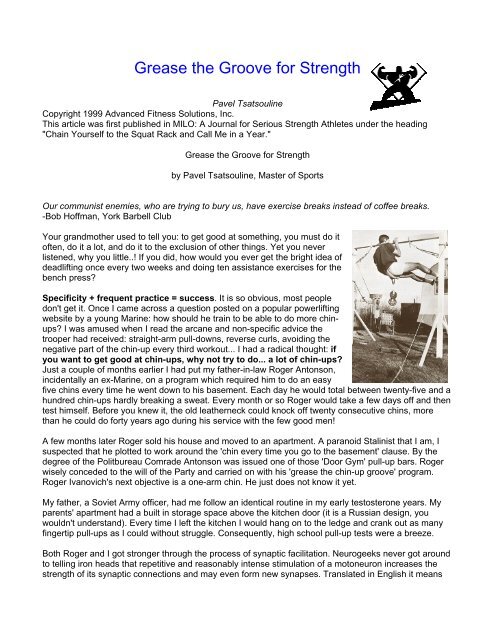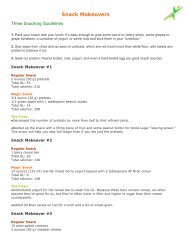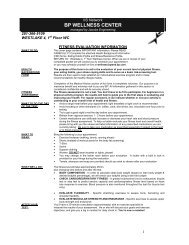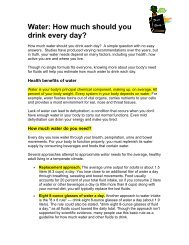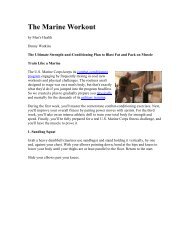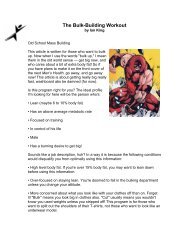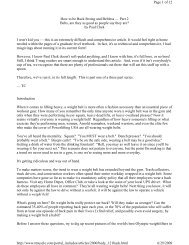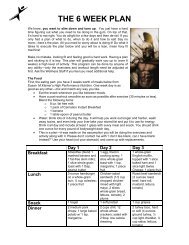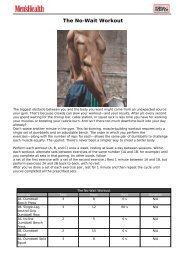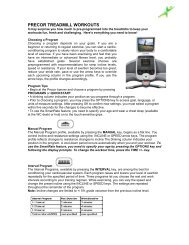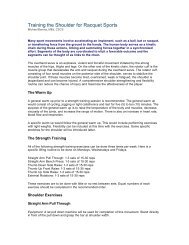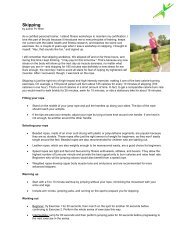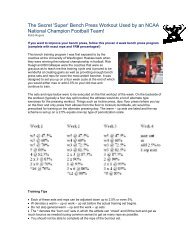Grease the Groove for Strength - Trainingdimensions
Grease the Groove for Strength - Trainingdimensions
Grease the Groove for Strength - Trainingdimensions
You also want an ePaper? Increase the reach of your titles
YUMPU automatically turns print PDFs into web optimized ePapers that Google loves.
<strong>Grease</strong> <strong>the</strong> <strong>Groove</strong> <strong>for</strong> <strong>Strength</strong><br />
Pavel Tsatsouline<br />
Copyright 1999 Advanced Fitness Solutions, Inc.<br />
This article was first published in MILO: A Journal <strong>for</strong> Serious <strong>Strength</strong> Athletes under <strong>the</strong> heading<br />
"Chain Yourself to <strong>the</strong> Squat Rack and Call Me in a Year."<br />
<strong>Grease</strong> <strong>the</strong> <strong>Groove</strong> <strong>for</strong> <strong>Strength</strong><br />
by Pavel Tsatsouline, Master of Sports<br />
Our communist enemies, who are trying to bury us, have exercise breaks instead of coffee breaks.<br />
-Bob Hoffman, York Barbell Club<br />
Your grandmo<strong>the</strong>r used to tell you: to get good at something, you must do it<br />
often, do it a lot, and do it to <strong>the</strong> exclusion of o<strong>the</strong>r things. Yet you never<br />
listened, why you little..! If you did, how would you ever get <strong>the</strong> bright idea of<br />
deadlifting once every two weeks and doing ten assistance exercises <strong>for</strong> <strong>the</strong><br />
bench press?<br />
Specificity + frequent practice = success. It is so obvious, most people<br />
don't get it. Once I came across a question posted on a popular powerlifting<br />
website by a young Marine: how should he train to be able to do more chinups?<br />
I was amused when I read <strong>the</strong> arcane and non-specific advice <strong>the</strong><br />
trooper had received: straight-arm pull-downs, reverse curls, avoiding <strong>the</strong><br />
negative part of <strong>the</strong> chin-up every third workout... I had a radical thought: if<br />
you want to get good at chin-ups, why not try to do... a lot of chin-ups?<br />
Just a couple of months earlier I had put my fa<strong>the</strong>r-in-law Roger Antonson,<br />
incidentally an ex-Marine, on a program which required him to do an easy<br />
five chins every time he went down to his basement. Each day he would total between twenty-five and a<br />
hundred chin-ups hardly breaking a sweat. Every month or so Roger would take a few days off and <strong>the</strong>n<br />
test himself. Be<strong>for</strong>e you knew it, <strong>the</strong> old lea<strong>the</strong>rneck could knock off twenty consecutive chins, more<br />
than he could do <strong>for</strong>ty years ago during his service with <strong>the</strong> few good men!<br />
A few months later Roger sold his house and moved to an apartment. A paranoid Stalinist that I am, I<br />
suspected that he plotted to work around <strong>the</strong> 'chin every time you go to <strong>the</strong> basement' clause. By <strong>the</strong><br />
degree of <strong>the</strong> Politbureau Comrade Antonson was issued one of those 'Door Gym' pull-up bars. Roger<br />
wisely conceded to <strong>the</strong> will of <strong>the</strong> Party and carried on with his 'grease <strong>the</strong> chin-up groove' program.<br />
Roger Ivanovich's next objective is a one-arm chin. He just does not know it yet.<br />
My fa<strong>the</strong>r, a Soviet Army officer, had me follow an identical routine in my early testosterone years. My<br />
parents' apartment had a built in storage space above <strong>the</strong> kitchen door (it is a Russian design, you<br />
wouldn't understand). Every time I left <strong>the</strong> kitchen I would hang on to <strong>the</strong> ledge and crank out as many<br />
fingertip pull-ups as I could without struggle. Consequently, high school pull-up tests were a breeze.<br />
Both Roger and I got stronger through <strong>the</strong> process of synaptic facilitation. Neurogeeks never got around<br />
to telling iron heads that repetitive and reasonably intense stimulation of a motoneuron increases <strong>the</strong><br />
strength of its synaptic connections and may even <strong>for</strong>m new synapses. Translated in English it means
that multiple repetitions of a bench press will 'grease up' this powerlift's groove. More 'juice' will reach<br />
<strong>the</strong> muscle when you are benching your max. The muscle will contract harder and you will have a new<br />
PR to brag about. Four times powerlifting world record holder Dr. Judd Biasiotto set up a bench in his<br />
kitchen, got in <strong>the</strong> habit of hitting it every time he was in <strong>the</strong> area and put up a 319BP @ 132!<br />
Obviously, you do not have to be a Commie weightlifter with Rocky IV pharmacy to benefit from high<br />
volume heavy training. Here is how you can to set up a 'grease <strong>the</strong> groove' program <strong>for</strong> one rep max<br />
strength or <strong>for</strong> strength endurance in your dungeon:<br />
1. Intensity<br />
The science of motor learning explains that an extreme, all out movement is operated by a program<br />
different from that used <strong>for</strong> <strong>the</strong> identical task per<strong>for</strong>med at a moderate intensity. As far as your nervous<br />
system is concerned, throwing a football <strong>for</strong> maximum distance is a totally different ball game than<br />
passing it ten yards, no pun intended. According to Russian scientist Matveyev (yeah, <strong>the</strong> chap who<br />
invented periodization), you must train with at least 80% 1RM weights if you intend to make a noticeable<br />
impact on your max. According to Prof. Verkhoshansky, ano<strong>the</strong>r mad scientist from <strong>the</strong> Empire of Evil,<br />
<strong>for</strong> elite athletes this minimal load is even higher -85% 1RM. Yet many comrades will be very successful<br />
greasing <strong>the</strong> groove with 60-80% weights as long <strong>the</strong>y emphasize <strong>the</strong> competitive technique -high<br />
tension, Power Breathing, etc.<br />
Naturally, if you are training <strong>for</strong> strength endurance ra<strong>the</strong>r than absolute strength, you should train with<br />
lighter loads. To meet <strong>the</strong> Soviet Special Forces pull-up standard of eighteen consecutive dead hang<br />
reps stick to your bodyweight plus heavy regulation boots.<br />
It is critical <strong>for</strong> <strong>the</strong> program's success that you avoid muscle failure as aerobic classes and rice cakes.<br />
Do not come even close to failure, whe<strong>the</strong>r you train <strong>for</strong> max or repetitions! A triple with a five-rep max<br />
or ten pull-ups if twenty is your PR will do <strong>the</strong> trick. The secret to this workout is per<strong>for</strong>ming a lot of work<br />
with reasonably heavy weights. Pushing to exhaustion will burn out your neuromuscular system and<br />
<strong>for</strong>ce you to cut back on <strong>the</strong> weights or tonnage.<br />
2. Repetitions<br />
According to <strong>for</strong>mer world weight lifting champion Prof. Arkady Vorobyev, one to six reps are optimal <strong>for</strong><br />
training of high caliber weightlifters and increasing this number hinders strength development. Or, as<br />
Luke Iams put it, "Anything over six reps is bodybuilding."<br />
Do more reps, and your body will think that you are practicing a totally different lift. Dr. Biasiotto who<br />
once squatted an unreal 605 @ 130 has switched to bodybuilding and knocks off 325x25 <strong>the</strong>se days.<br />
His legs are no longer 'a pair of pliers in shorts' as <strong>the</strong>y used to be in his days of heavy triples and world<br />
records, but he would be <strong>the</strong> first one to tell you that <strong>the</strong>re is no way he could put up a massive single<br />
training this way.<br />
Of course, <strong>for</strong> bodyweight pull-ups, push-ups, and o<strong>the</strong>r commando feats of staying power you will need<br />
to bump up <strong>the</strong> reps to satisfy <strong>the</strong> law of specificity. Roger Antonson worked up to training sets of nine<br />
by <strong>the</strong> time he set a personal record of twenty chin-ups.
3. Volume<br />
Vitaly Regulyan, one of <strong>the</strong> top Russian benchers, does fifty to seventy heavy sets per lift! What are<br />
YOU waiting <strong>for</strong>? A permission from Mike Mentzer? Up <strong>the</strong> volume!<br />
'High volume' does NOT mean a lot of reps with Barbie weights. Such training is good or nothing but a<br />
muscle pumper's virtual muscle. Do I sound like Anthony Dittillo? -Good, <strong>the</strong> man is right, give him a<br />
cigar! 'High volume' on <strong>the</strong> synaptic facilitation power plan means maximizing your weekly tonnage with<br />
heavy weights.<br />
'Tonnage' -or 'poundage' if you are not up on <strong>the</strong> metric system -refers to <strong>the</strong> total weight lifted in a given<br />
period of time, <strong>for</strong> example a day, a week, a mesocycle. Say your best deadlift is 500x1 and last week<br />
you did <strong>the</strong> following pulls: 400x5/20, 450x2/50. Here is how to calculate your weekly deadlift poundage:<br />
(400x5x20) + (450x2x50) = 85,000. As this number grows, so will your strength, at least up to a point.<br />
Make sure that volume does not come at <strong>the</strong> expense of intensity. Average intensity is calculated by<br />
dividing <strong>the</strong> poundage by <strong>the</strong> total number of lifts: 85,000 : 200 = 425 pounds. Intensity can be<br />
expressed in pounds or % 1RM. In <strong>the</strong> above example 425 pounds is 82,5% of 500 pounds one rep<br />
max; <strong>the</strong> intensity is on <strong>the</strong> money.<br />
The strong man must make an ef<strong>for</strong>t to gradually build up both <strong>the</strong> volume and <strong>the</strong> intensity while<br />
making sure his body can handle <strong>the</strong> load and does not overtrain. Trite as it sounds, listen to your body.<br />
4. Frequency<br />
Prof. Vladimir Zatsiorsky, a Soviet strength expert who jump shipped from <strong>the</strong> Dark Side of <strong>the</strong> Force to<br />
America, summed up effective strength building as training as often as possible while being as fresh as<br />
possible. An eighties study by Gillam found that increasing training frequency up to five days a week<br />
improved <strong>the</strong> results in <strong>the</strong> bench press, something big Jim Williams knew a decade earlier when he<br />
benched in <strong>the</strong> neighbourhood of 700. Ditto <strong>for</strong> Dr. Judd. Be<strong>for</strong>e Biasiotto took up benching in <strong>the</strong> midst<br />
of his kitchen appliances, he had worked out in his training partner's spider web insulated and rat<br />
infested garage where he benched five times a week <strong>for</strong> fifteen heavy sets within an hour. That brutally<br />
efficient routine boosted skinny Judd's bench from 140 to 295 pounds in nine months!<br />
Russian strength researchers discovered that fragmentation of <strong>the</strong> training volume into smaller units is<br />
very effective <strong>for</strong> promoting strength adaptation, especially in <strong>the</strong> nervous system. In o<strong>the</strong>r words, one<br />
set of five every day is better than five sets of five every five days.<br />
It is even better if you chop up your daily workload into multiple sessions. Motor learning comrades<br />
know that while <strong>the</strong> total number of trials is important, <strong>the</strong> frequency of practice is even more critical<br />
than <strong>the</strong> total volume. Paul Anderson had it all figured out when he supersetted heavy triples in <strong>the</strong><br />
squat with gallons of milk throughout <strong>the</strong> day. If you can swing it -all <strong>the</strong> power to you, people!<br />
5. Exercise selection<br />
Concentrate your gains on <strong>the</strong> snatch and <strong>the</strong> C&J, SQ-BP-DL, or any o<strong>the</strong>r few select lifts and <strong>for</strong>get<br />
assistance work! The synaptic facilitation approach is very powerful because it greases <strong>the</strong> specific<br />
groove of your pet feat. Additional exercises will just distract you from your purpose. I plan to expand on<br />
<strong>the</strong> cloudy issue of specificity of strength in a future article. For now, be a good Communist and show<br />
some blind faith!
The synaptic facilitation power plan can be summed up as lifting heavy weights as often as possible<br />
while staying 'fresh as a cucumber' (Russkies have a thing against daisies, you wouldn't understand).<br />
Contrary to what some snobby pantywaists believe, this heavy, high volume approach is not an iron<br />
fossil but one of <strong>the</strong> most scientific approaches to strength training <strong>the</strong>re is. "Chain yourself to <strong>the</strong> squat<br />
rack and call me in a year." Words to live by.<br />
# # #<br />
Read about Clarence 'Ripped' Bass' experiment with <strong>the</strong> above method on<br />
http://cbass.com/Synaptic.htm. Learn more cutting edge strength building techniques in Pavel's books<br />
Power to <strong>the</strong> People!, The Russian Kettlebell Challenge, and Bullet-Proof Abs.


